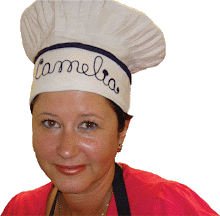Time goes by so quickly it is scary! We are here again doing the mad Xmas rush planning our wonderful feasts to please our friends and family.... the one time we say never mind the calories lets eat eat!! This months recipe was inspired by my good friend Carmen who is my local vino supplier! She wanted something special for her 50th birthday and ironic as it sounds wanted English fare roast beef, chutneys etc, she mentioned that whilst living in London she saw a beautifully decorated salmon in a restaurant and had never forgotten it, so as a surprise I did one for her! She was so pleased as were her Spanish guests but the best part for me was she requested a prawn curry which I accompanied with Poppodums on the Monday she informed me the food was fab but " oh that lovely bread Papdoomies were the highlight of the day!!" Just shows how we take things in our culture for granted!!This salmon is something to impress as a centrepiece on your Christmas or New Year buffet and whilst looks impressive is in reality so so easy to do. Be as artistic or as simple as you want the end result will always please and served with a nice mayo flavoured perhaps with lemon or a little smoked paprika will definitely give your handywork the wow factor! I am so pleased to have been in this months Town and Village and love receiving your comments so please keep them coming and let me know how you get on with the recipes.
We are still loving our time in sunny Spain, I did a weird thing yesterday ... bought our tree at 6.pm it was 22 degrees, a mackerel sky tinged with pink waiting for the sun to set quite surreal I have never bought a Christmas tree in warm sunshine before!! Especially as I hear just 2 hours away in England it is icy and freezing!
I would like to wish you all a very Merry Xmas a Prosperous New Year and lots of happy eating!!
Camelia xx





